choosing a teapot
Choosing a teapot from the plethora of choices available can be a daunting task. Teapots are available in an array of different materials such as ceramic, glass, clay, bone china so name a few. The first criteria that comes to mind for selecting a teapot is based on the visual appeal and how well it will fit with the decor, but one may also want to look at the type of tea used and how best to brew the tea leaves.Yixing Teapots
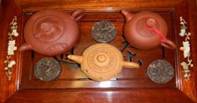 These teapots date from the Ming Dynasty (1368-1644) and are both artistic and functional. These pots are collectibles because of their shapes that can be whimsical, animals, flowers, dragons or sleek and elegant. Natural minerals contained in the clay of the Yixing region of China produce a variety of colors when fired. The chop mark on the bottom of the teapot denotes the artist and that this is a quality teapot that will last decades with proper care.
These teapots date from the Ming Dynasty (1368-1644) and are both artistic and functional. These pots are collectibles because of their shapes that can be whimsical, animals, flowers, dragons or sleek and elegant. Natural minerals contained in the clay of the Yixing region of China produce a variety of colors when fired. The chop mark on the bottom of the teapot denotes the artist and that this is a quality teapot that will last decades with proper care.
The inside of a Yixing teapot is unglazed, so one must always brew the same tea in the teapot so that it can absorb the oil from the tea. For example, if you brew Sencha in your Yixing teapot, do not brew any other tea in the same pot. If you brew different types of tea in this teapot, the oils from the tea will be absorbed into the clay and will mix and you will not be able to enjoy the true flavor and aroma of the tea. To receive the best benefit from this special teapot, consider brewing only your all time favorite tea in your Yixing. Over time, the teapot will absorb enough oils from the tea that the aroma and flavor will come through by just adding hot water to the teapot without using any tea leaves.
The Yixing teapot must be sterilized and seasoned before use. Place a terry cloth towel in the bottom of a pot. Put the teapot on one side of the towel and the lid on the other. Cover with cold water. Bring the water to a boil and boil for 20 minutes to remove any loose clay or impurities. Remove the pot from the water and cool a little. Place twice the amount of tea leaves into the pot than you would normally use (ex. If the pot brews one cup of tea then place 2 tsp. into the pot.) Add hot water and let the tea steep until cool. Pour out the tea and repeat twice more. Be sure to use the type of tea that you will always be brewing in the teapot. Rinse the teapot in warm water and allow the teapot to thoroughly air dry before replacing the lid. Never use soap or place it in the dishwasher.
Tetsubin 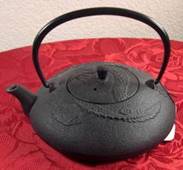 The tetsubin (tet-SUE-bin) teapot is a Japanese teapot made of cast iron. Exactly when the tetsubin first appeared in Japan is unclear, but evidence does suggest a close relationship with the rise of the Sencha form of drinking tea that uses tea leaves instead of powdered tea. Before Sencha, tea drinking was not popular with the common citizens. Only the wealthy could afford Matcha (a type of powder used to brew tea.) When the Chinese introduced Sencha (brewing tea with whole leaves instead of powder) was introduced to Japan, tea drinking became affordable and more accessible to all the Japanese people.
The tetsubin (tet-SUE-bin) teapot is a Japanese teapot made of cast iron. Exactly when the tetsubin first appeared in Japan is unclear, but evidence does suggest a close relationship with the rise of the Sencha form of drinking tea that uses tea leaves instead of powdered tea. Before Sencha, tea drinking was not popular with the common citizens. Only the wealthy could afford Matcha (a type of powder used to brew tea.) When the Chinese introduced Sencha (brewing tea with whole leaves instead of powder) was introduced to Japan, tea drinking became affordable and more accessible to all the Japanese people.
The original tetsubin teapots were originally used as common kitchen item used to provide hot water, warmth, and humidity to the household. They were simple and were not very ornate until the 19th century when Japanese art became a cultural revolution. The tetsubin style and design slowly became more elaborate and soon a wide range of teapots were available from simple to designed works of art. Some of the tetsubin pots were decorated with high relief designs and inlays of gold, silver, and copper. These teapots evolved into a status symbol; the more elaborate the teapot the more prestigious one was in social status.
Today, the Tetsubin teapot is a beautiful reflection of the Japanese culture and history. The design and shape of the teapot is simple and beautiful, while being practical. Tea enthusiasts claim that tea brewed in these cast iron teapot tastes better than tea brewed in any other type of teapot. Tetsubin teapots are highly collectible and are still hand-cast by master artists and have unto themselves become simple works of art to truly reflect the Japanese art culture.
Care and Use of Tetsubin Teapots
Never place on the stove, since this is a teapot not a kettle.
Do not leave tea standing in the tetsubin teapot for a long period of time.
Do not wash the tetsubin teapot with abrasive pads or harsh detergents. Simply rinse with plain water and wipe dry after each use.
Make sure to fully dry the tetsubin teapot before storing.
Cast Iron Teapots These teapots are very similar to tetsubin teapots. The difference is that they are not made in Japan and are usually machine cast. They come in many different colors and motifs. These teapots are less expensive, but still are very nice. As with any cast iron teapot make sure that the inside of the teapot and lid are fully glazed to prevent rusting.
Brown Betty Teapot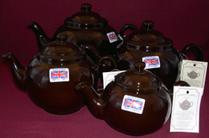 These are traditional teapot still made in Stoke-on-Trent, England from red terra cotta clay. This teapot dates back to the end of the 17th Century and became very popular when tea became a symbol of Britain's greatest period of expansion and stability. Almost every home had a teapot, since tea was no longer considered an upper class beverage.
These are traditional teapot still made in Stoke-on-Trent, England from red terra cotta clay. This teapot dates back to the end of the 17th Century and became very popular when tea became a symbol of Britain's greatest period of expansion and stability. Almost every home had a teapot, since tea was no longer considered an upper class beverage.
The Brown Betty teapot was a basic teapot that was affordable for most people during this time. This teapot was also believed to make the best tasting pot of tea because of the type of clay that was used (during this time period, the Brown Betty was unglazed) and the shape of the pot. The shape of the pot causes the tea leaves to be gently swirled around as the boiling water is added to produce a wonderful infusion. Rockingham glaze gives the Brown Betty teapot the deep, dark brown color that has made them famous and easily recognizable. The glaze also hides any tea stains from the tea oils. These teapots are available in 2, 4, 6, and 8 cup sizes. The Brown Betty teapot is dishwasher safe, however the best care for the teapot is to rinse in hot water and allowed to air dry.
Bone China Teapots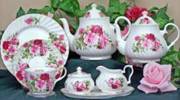 Bone china is made of porcelain and bone ash. This makes the china lighter and stronger than porcelain. This is what gives bone china mugs and teacups their thin rims and makes sipping a cup of tea more enjoyable. Creating bone china is very labor intensive and is reflected in the price. It is easy to tell if your piece is bone china or porcelain. Simple hold it up to the light and it will have a white, translucent look if it is bone china.
Bone china is made of porcelain and bone ash. This makes the china lighter and stronger than porcelain. This is what gives bone china mugs and teacups their thin rims and makes sipping a cup of tea more enjoyable. Creating bone china is very labor intensive and is reflected in the price. It is easy to tell if your piece is bone china or porcelain. Simple hold it up to the light and it will have a white, translucent look if it is bone china.
To protect your bone china hand wash in warm soapy water. For best results bone china should not be placed in the dishwasher.
Porcelain Teapots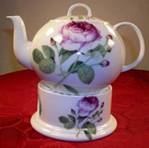 Porcelain is a strong, translucent ceramic material fired at a low temperature. The glaze is then fired at a very high temperature to set it. Since porcelain goes through several fewer steps to produce than bone china, the price is much more affordable. These teapots are available in a wide variety of shapes, colors, and decorations.
Porcelain is a strong, translucent ceramic material fired at a low temperature. The glaze is then fired at a very high temperature to set it. Since porcelain goes through several fewer steps to produce than bone china, the price is much more affordable. These teapots are available in a wide variety of shapes, colors, and decorations.
Porcelain is dishwasher safe. For best results porcelain should be place in the top drawer of the dishwasher.
Glass Teapots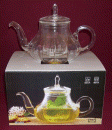 Glass teapots are great for those who enjoy drinking green tea, black tea, and herbals. These teapots are nonporous and do not hold any oils. They are also perfect for brewing artisan teas to enjoy the full visual display as they open to reveal the flowers tied inside the leaves. This type of teapot washes clean and does not leave any stains even from fruit blend teas that are known to stain some types of teapots pink from the hibiscus flowers that are often a base for these teas.
Glass teapots are great for those who enjoy drinking green tea, black tea, and herbals. These teapots are nonporous and do not hold any oils. They are also perfect for brewing artisan teas to enjoy the full visual display as they open to reveal the flowers tied inside the leaves. This type of teapot washes clean and does not leave any stains even from fruit blend teas that are known to stain some types of teapots pink from the hibiscus flowers that are often a base for these teas.
The teapot is dishwasher safe. When cleaning by hand never clean the spout with a dishcloth. Use a small brush to avoid breaking the spout.
